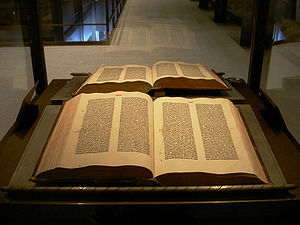Beinecke Rare Book & Manuscript Library





Yale University's Beinecke Rare Book and Manuscript Library was a 1963 gift of the Beinecke family. The building, designed by architect Gordon Bunshaft, of the firm of Skidmore, Owings, and Merrill, is the largest building in the world reserved exclusively for the preservation of rare books and manuscripts. It is built at the center of the University, in Hewitt Quadrangle, which is more commonly referred to as "Beinecke Plaza". A six-story above-ground tower of book stacks is surrounded by a windowless rectangular building with walls made of a translucent Danby marble, which transmit subdued lighting and provide protection from direct light. Three floors of stacks extend under Hewitt Quadrangle. The sculptures in the sunken courtyard are by Isamu Noguchi and are said to represent time (the pyramid), sun (the circle), and chance (the cube). The library also contains an exhibition hall that, among other things, displays one of the 48 existent copies of the Gutenberg Bible, study areas, reading rooms, the catalogue room, microfilm room, offices, and the book storage areas. The two books of the Gutenberg Bible are left open in a display case, and the librarians at Beinecke are said to turn one page of each book daily.
The display of the original core of the British Library, the original gift of King George III, as found in the new British Library building at Euston in London, is designed as a silent tribute to the elegance of the Beinecke.
During the 1960s, Claes Oldenburg's sculpture "Lipstick on a Caterpillar Track" was displayed in Hewitt Quadrangle. The sculpture has since been moved to the courtyard of Morse College, one of the university's residential dormitories.
Edward Forbes Smiley III, an antiques dealer, was caught slicing maps from rare books with an X-acto blade. He had dropped it on the floor and it was spotted by a diligent worker.
History
In the late 19th century the rarer and more valuable books of the Library of Yale College were placed on special shelving at the Old Library (now Dwight Hall). These were moved to the Rare Book Room collection of Sterling Memorial Library when it opened in 1930. When the Beinecke Rare Book and Manuscript Library opened its doors on October 14, 1963, it had become the home of the volumes from the Sterling Memorial Library Rare Book Room, and three special collections—the Collection of American Literature, the Collection of Western Americana, and the Collection of German Literature. Shortly afterward, they were joined by the James Marshall and Marie-Louise Osborn Collection. Beinecke Library became the repository for books in the Yale collection printed anywhere before 1601, books printed in Latin America before 1751, books printed in North America before 1821, newspapers and broadsides printed in the United States before 1851, European tracts and pamphlets printed before 1801, and Slavic, East European, Near and Middle Eastern books through the eighteenth century, as well as special books outside these categories.
Special collections
The holdings of the Beinecke Library include
- American Children's Literature
- John James Audubon (including two copies of the double elephant folio of Birds of America)
- James M. Barrie
- John Baskerville
- William Thomas Beckford
- Sir John Betjeman
- John Boswell
- Bryher
- Cartography, including the "Vinland Map"
- Ernst Cassirer
- Congregationalism
- Joseph Conrad
- Walter Crane
- Dada
- Daniel Defoe
- Charles Dickens
- Norman Douglas
- Jonathan Edwards
- George Eliot
- the Elizabethan Club collection (composed of about 300 volumes of sixteenth- and seventeenth-century literature, including the first four folios of Shakespeare, the Huth Shakespeare quartos, and first or early quartos of all the major dramatists)
- Erasmus and his contemporaries
- Faust
- Henry Fielding
- Benjamin Franklin
- Goethe
- Greek and Latin Literature
- Thomas Hardy
- Humanism
- Incunabula (over 3100 volumes including the Melk copy of the Gutenberg Bible)
- the James Weldon Johnson Collection
- James Joyce
- Judaica
- Rudyard Kipling
- D. H. Lawrence
- Doris Lessing
- pre-1660 manuscripts (including more than 1,100 medieval and Renaissance codices and several hundred manuscript fragments dating from the fourth century through the Renaissance, as well as the Voynich Manuscript)
- Thomas Mann
- John Masefield
- the Mellon Collection of Alchemy and the Occult
- George Meredith
- Ornithology
- the Papyrus Collection
- Playing Cards
- Polish Literature
- Dorothy Richardson
- Rilke
- Rochambeau Family
- Bruce Rogers
- the Romanov Family
- Olga Rudge Papers
- John Ruskin
- Russian Literature
- Schiller
- Sixteenth-Century Printed Books
- Sporting Books
- the Gertrude Stein and Alice B. Toklas Collection
- Robert Louis Stevenson
- Alexis de Tocqueville
- Vanderbilt Collection
- Carl Van Vechten
- Rebecca West
- the Thornton Wilder papers
- Kurt Wolff
In popular culture
- In Uncommon Carriers, John McPhee admires a restaurant's display of "a glass tower of recumbent wines that may have been an architectural reference to the glass column of visible books in the Beinecke Library at Yale."[1]
- In The Once and Future Spy by Robert Littell, an assassination attempt is made on a CIA analyst at the Beinecke Library.
References
- ^ McPhee, John (2006). Uncommon Carriers. Farrar, Strauss and Giroux. ISBN 0-374-28039-8., p. 129

